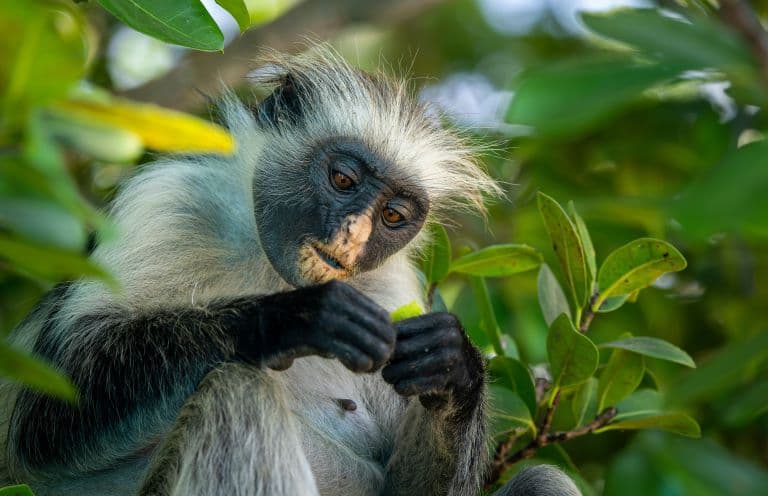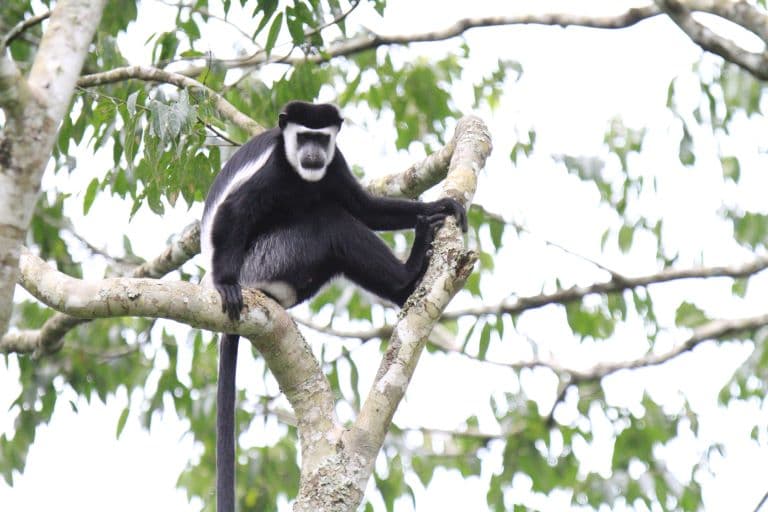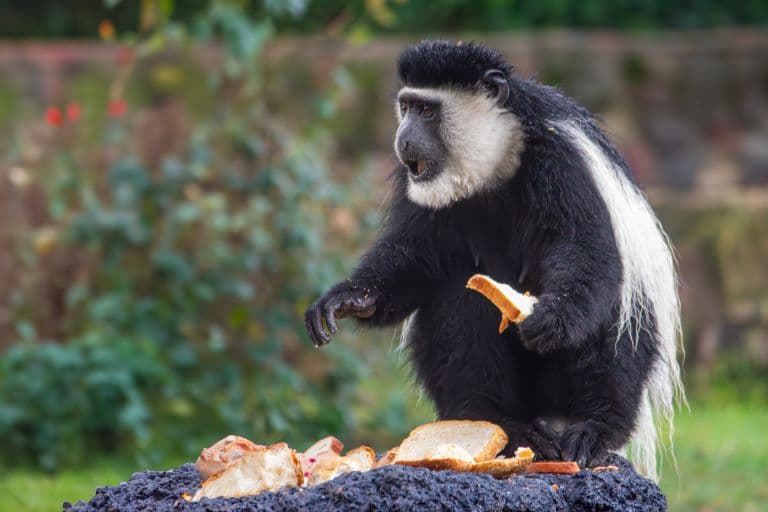Colobus MonkeyProfile
In rainforest canopies all over Africa, there’s a monkey whose expression suggests it was once something much far glamorous and doesn’t much like being a monkey at all.
Sitting in the tree tops with a perpetual frown, it’s easy to imagine this is an animal that once did something to upset a witch and was cursed to live its days outside in the rain.
This is the black and white colobus monkey, and along with its cousins the olive and red colobus monkeys, it’s part of the colobine tribe. All of whom look a little disappointed in one way or another.

Colobus Monkey Facts Overview
| Habitat: | Forest canopy |
| Location: | Pan African |
| Lifespan: | 20-30 years |
| Size: | Up to around |
| Weight: | Around 15kg (33lb) max |
| Colour: | Varies between species |
| Diet: | Mostly leaves, some fruit and seeds |
| Predators: | Chimps, humans, cats, |
| Top Speed: | Not recorded |
| No. of Species: | Around 24 |
| Conservation Status: | Most are vulnerable to critically endangered. |
Ironically, the Eastern black and white Colobus has the least to frown about, as it’s one of the few Colobus species that’s listed as of least concern for conservation.
Sadly, most colobus monkeys are in serious trouble.
There are several species, spread out all over Africa, and while some are bold and loud and daring, others are shy and quiet and prefer to keep to themselves.
Regardless, all are important to the ecosystem and are worthy of protection from the numerous threats they face from human activities.
Interesting Colobus Monkey Facts
1. It’s not all black and white
This might suggest that there’s more than meets the eye when it comes to colobus monkeys, but each genus is named after the colour of its members.
While the guereza or Eastern black and white Colobus is the most easily recognisable of these monkeys, there are plenty more that look completely different.
The colobine tribe includes three extant genera of African leaf-eating monkeys, one of which is the genus Colobus, to which the guereza belongs, but the red Colobus and olive Colobus occupy the genera Piliocolobus and Procolobus, respectively.

2. They have bare bums
This is not exclusive to Colobus monkeys, but it’s something the entire family has evolved. Every member of the Cercopithecidae has toughened, hairless booty pads called Ischial Callosities.
These nerveless, thickened butt cushions are thought to provide much-needed protection against long periods of sitting on hard branches and allow the monkey to spend long periods without having to change positions to avoid pins and needles.
It’s also thought to aid with grip on the crowns of trees and while sleeping on narrow branches. 1

3. They’re spies
Red colobus monkeys are a vibrant bunch. True to their name, they exhibit heightened aggression and tend to make a lot of noise.
These monkeys occupy large troops of chavvy families, spreading out over the forest canopy and generally making the place look untidy.
As offspring reach adolescence, they’re often cast out of the troop if they’re male, and seem to voluntarily leave if they’re female.
Females are more welcome in strange troops than males, as it’s common for established troops to straight-up murder any stranger that tries to integrate with them. As such, many males will choose to try and re-enter their natal group after the nomadic phase is over.
However, if a male has his heart set on joining a new family, it can take months or even years to wait for a vacancy.
In some cases, red colobus monkeys have been seen shacking up with local populations of the far more tolerant Green monkeys as a way of staying close to the desired group and spying on their politics. 2
4. They’re not all brash
The Olive Colobus monkeys are a lot less exhibitionist. They don’t follow the vibrant colouration or the loud-mouthed attitudes of their larger cousins, possibly because they’re the smallest of the lot, and as such, prefer to hide.
This shyness and camouflage have allowed the Olive Colobus to go unspotted, even by researchers. And by sneaking around quietly, they’re actually relatively good at surviving in areas where others can’t – something we’ll come back to shortly.
5. They’re messy eaters
Most species have some sloppy habits when it comes to food, and this is a great thing for the ecosystems they inhabit.
By routinely dropping bits of fruit, these monkeys spread seeds around the forest, helping to distribute plant species as they go.
And in many cases, their poop contains seeds which are not only undamaged by the monkey’s digestion but enzymatically primed to germinate and grow even better than if they hadn’t been eaten.
This makes colobus monkeys an important component of the balanced ecosystem and provides all the more reason for their protection.

6. They’re in decline
And that protection couldn’t come any sooner. The population of every colobus species listed on the IUCN red list is decreasing in number.
The red colobus, for example, on account of their aforementioned heaviness, make themselves easy to find and are consequently hunted more than almost any other species.
The black and white colobus monkeys are hunted for their beautiful fur, as well as for food.
But all species are predominantly threatened by forest clearance. Human population growth and increases in demand for meat and cocoa have led to widespread deforestation across the continent, and this has come at a cost to forest species like the colobus.
As it is, populations of all species are decreasing, and all but the Guereza lie somewhere between vulnerable and critically endangered on the conservation scale. 3
7. Yet some are surprisingly resilient
The Olive Colobus, the small, shy member of the tribe, tries not to make much of a fuss. It’s happiest in primary forests, but even recovering forests can sustain large populations.
Due to their small size, they can live in heavily degraded areas where food sources would be too slim for a larger species.
Unfortunately, even recovering forests are being destroyed for farmland, which contributes significantly to this monkey’s population decline, but of the three genera, this one appears to be the most resilient.
Conservation efforts for all species revolve around protecting habitat and reducing poaching, though a lot more has to be done to reverse the negative trend in their numbers. With a little help, some, if not all colobus species could make a quick recovery. 4
Colobus Monkey Fact-File Summary
Scientific Classification
| Kingdom: | Animalia |
| Phylum: | Chordata |
| Class: | Mammalia |
| Order: | Primates |
| Family: | Cercopithecidae |
| Tribe: | Colobini |
Fact Sources & References
- W. Scott McGraw (2017), “Ischial Callosities”, Wiley Online Library.
- Starin, E.D. (1994), “Philopatry and Affiliation Among Red Colobus”, Sci Hub.
- (Year), “colobus”, IUCN Red List.
- “Conserving & Protecting The Threatened Primates Of Kenya And Their Habitats!”, Colobus Conservation.
